by Giselle Courteau
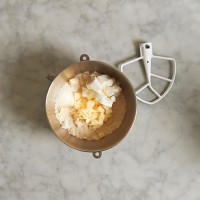 |
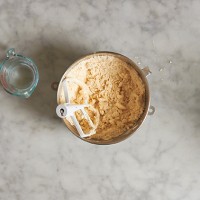 |
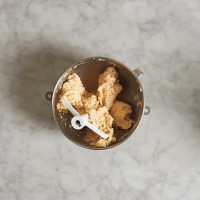 |
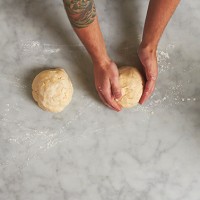 |
Giselle Courteau is co-founder of the beloved Duchess Bakeshop. Everyone has a favourite can’t-live-without item from the Duchess, but along with their stellar macarons, Duchess is probably best known for their delicious pies and tarts. Giselle generously shares her love of pie, tips and tricks for making pie plus two recipes from the Duchess Bake Shop Cookbook.
Growing up in Spruce Grove, my mom and I had a simple tradition of baking tourtière pies together. Well, more like she’d make them, and I’d just make a mess. I was three years old when I first began baking with my mom, and while I wasn’t much help with making the pie dough, I always helped with the assembly, rolling out the dough and filling the shells with a savoury pork filling.
The tradition continued over the years, and the smell of cloves and pork still reminds me of that time. We’d make forty of these tourtière, which mom par-baked and froze to have on hand for special holidays throughout the year.
Pie dough seemed like this magical bunny that miraculously appeared out of my mother’s hat. So when I started baking in earnest in high school, I baked everything but pies. I was terrified of it. ‘What if it turns out hard as a rock,’ I’d ask myself. ‘How could I get that flaky texture I love? What if it’s not flavourful at all?’ Self- doubt always hovered over my shoulder until another woman entered my life.
As many do, I looked up to Julia Child. In my early 20s I bought Baking with Julia, and read it every night before bed. I’d read the book back-to-back four times before building up the courage to tackle pie dough. Armed with bravado and Julia’s imaginary hands, I took a deep breath and started mixing flour and butter, shortening and salt, and a bit of ice water.
The first pie dough I ever made was from that book and, it was amazing! I still remember pulling that first apple pie out of the oven, all golden and bubbly, and when Garner saw it, he said, “Wow, that is a good pie!”
I quickly realized there was no magic involved, and making pie dough was nothing to be feared at all. With my new-found confidence, I made apple pie, then peach, then strawberry–rhubarb. When I’d exhausted all my recipes, I called my mom for more. Just like anything else I learn to do, once I did it I gained a little more confidence each time.
Trust me, it’s easy to make pie dough, and you can master it quickly. Here are two critical tips to get you baking right away:
Make sure your butter and shortening are really cold and use ice water.
Do not over mix the dough. You need the butter and shortening to remain lumpy because, when they melt during baking, they leave behind pockets in the crust, creating perfect, flaky goodness.
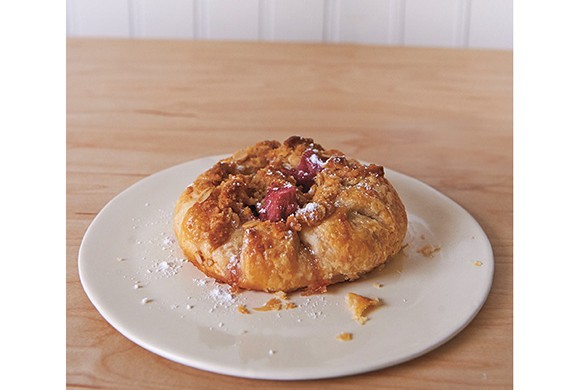
Tips to better pies
Use a stand mixer: For a short time, we mixed our pie dough at the bakery by hand until we could not keep up. We introduced the mixer and haven’t looked back because the piecrust is just as good. To mix, put the flour, butter, shortening and salt in your mixer with a paddle attachment and, on speed 1, mix just enough for the fat to be small chunks. This should only take 10-15 seconds and the mixture should still look slightly dry. Still on speed 1, add your ice-cold water all at once. Mix only long enough for a dough to form.
The shortening versus butter debate: My mom made an all-lard dough, and the more research I did, I realized that butter gives it flavour but shortening makes it flaky. I like to use a fifty-fifty mix. Pies are the only item we use shortening for at Duchess.
Pre-bake anything without a top: (otherwise known as par-bake) When you make a pie with a crumble topping, it’s a good idea to par-bake the shell first, which means baking it not all the way through. To do so, roll out the dough, place in the pie plate and poke with a fork. Next, line it with parchment and weigh it down with pie weights, beans or rice on top. Place it in the oven and when it is almost done, pull out the pie and remove the weights. Place the shell back in the oven and bake until golden brown (about 5 minutes).
Use a pie wash and don’t be stingy: To give your pie that shiny, golden look, mix egg whites and a little bit of cream, and brush the egg-wash all over the top and sides. Don’t forget the little nooks and crannies! The same goes for the sugar: sprinkle it on generously and it will caramelize beautifully.
Freeze pie dough in balls: Dough can last in the freezer for up to six months, so make your dough in batches and freeze what you don’t use.
Baking times: When baking pies, always position your oven rack in the middle of the oven. Baking times may vary depending on your oven, the depth of your pie plate, and whether you’re using disposable aluminum pie plates or glass/ceramic ones. All of our recipes are tested using glass pie plates, but even if that’s what you’re using too, you should use our baking times as a guideline only.
Getting the perfect pie crust is really about checking the pastry during baking for the right colour. For a blind-baked shell, it should be a light golden brown; for covered and lattice-top pies, it should be a medium to darker golden brown. Place pies directly on the oven rack for baking rather than on a tray. If you’re concerned about dripping, place a piece of aluminum foil on the rack below.
Experiment with fillings: Sweet or savoury, open or closed, pies, tourtières, quiches or tarts—once you master pie dough there are no limits on what you can do with it.
Easy Mixer Pie Dough
Makes 3, 9-inch pie shells or 1 covered or lattice-top pie plus an extra shell. This recipe will make more than you need for our pie recipes. Pie dough can be stored in the refrigerator for up to two days or in the freezer for up to six months. You can easily halve this recipe to make exactly what you need for one pie, but because pie dough freezes so well, I always like to make the full recipe and keep the extra dough in my freezer ready to go for when I need to make dessert in a pinch.
We use a 9-inch pie plate (standard, not deep dish). If your pie plate is a different size, you may need to adjust baking times accordingly; for smaller pies, be careful not to overfill the shells. You will need a stand mixer fitted with a paddle attachment.
Saksatoon Pie
| 640 g (4 cups) | all-purpose flour |
| 226 g (1 cup) | unsalted butter, in ½-inch cubes, cold |
| 200 g (1 cup) | vegetable shortening, in ½-inch cubes, cold |
| 1 tsp | salt |
| 242 g (1 cup) | ice water |
Place the flour, butter, shortening, and salt into a stand mixer bowl. Mix on low speed until the fats are in small chunks and the mixture looks a bit dry. This should only take 10 to 15 seconds.
Add the ice water all at once and mix on medium speed until the dough just comes together. Some small lumps of fat should remain in the dough.
Shape the dough into three balls. Wrap each ball in plastic wrap and refrigerate for at least 30 minutes, making sure the dough is fully chilled before rolling out. At this point the dough can be frozen. Let it thaw completely before using it, but when you roll it out, be sure it’s still cold.
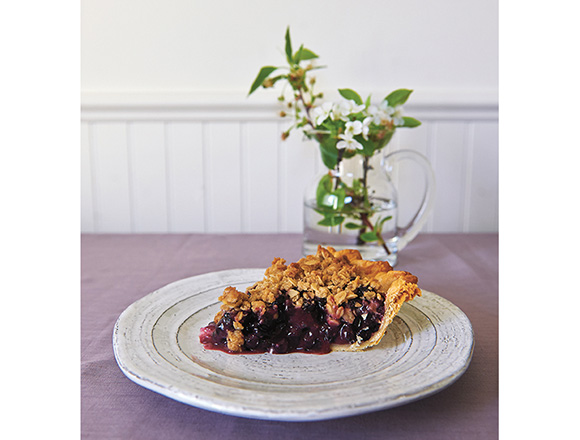
I remember spending summers picking saskatoons at the lake with my family. I would go home with my picking bucket nearly empty as I spent most of the time just eating berries off the bushes.
This pie was inspired by farmer Wade of Berry Ridge Orchards. He came into the shop in overalls with a video of his saskatoon farm, and we said, “We’d love a local saskatoon supplier!” Last summer, we sold a variation of this pie by adding fresh raspberries on the bottom then poured the cooked saskatoon filling on top.
Pie Dough
| 1 batch | easy mixer pie dough |
| 1 | large egg white |
| 1 T | cream |
Crumble Topping
| 45 g (½ cup) | old-fashioned rolled oats |
| 55 g (⅓ cup) | all-purpose flour |
| 55 g (⅓ cup) | firmly packed brown sugar |
| ¼ t | ground cinnamon |
| 55 g (¼ cup) | unsalted butter, at room temperature |
Combine the oats, flour, brown sugar, and cinnamon in a bowl, Add the butter and, using your hands, work it into the dry ingredients until large clumps form. Set aside.
Saskatoon Filling
| 880 g (6 cups) | fresh or frozen saskatoons |
| 3 T | water |
| 3 T | fresh lemon juice |
| 200 g (1 cup) | sugar |
| 55 g (⅓ cup) | all-purpose flour |
| ¼ t | ground nutmeg |
| 1 T | cornstarch |
To make the filling, in a saucepan, combine the saskatoons, water, lemon juice, and sugar. Cook over medium heat until the sugar dissolves and the mixture begins to simmer. Stir in the remaining ingredients and continue to cook until the mixture thickens.
Preheat your oven to 375°F (190°C).
Fill the shell to the rim with the saskatoon filling and generously top with crumb topping. Bake the pie for 45 to 50 minutes, until the top is golden brown and the filling is bubbling. Serve the pie slightly warm or let it cool completely.
This pie will keep at room temperature for up to three days. Makes 1, 9-inch pie.